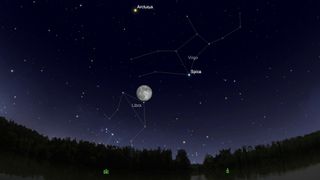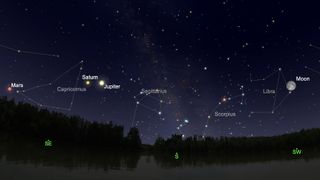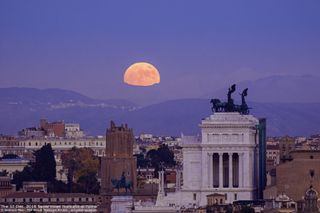'Full Flower Moon': See the last supermoon of 2020 at its best in these webcasts
May's full moon is Thursday, May 7, but you can see it at its best tonight!
Get set for the "super" Full Flower Moon of May! The full moon will occur on Thursday (May 7) at 6:45 a.m. EDT (1045 GMT), and it will be the last supermoon of 2020. See it at its fullest and brightest tonight (May 6) with your own eyes or a live webcast.
The full moon arrives just 32 hours after the moon reached perigee, or the closest approach to Earth in its orbit. That makes this a "supermoon," according to NASA.
You will see a very subtle difference in the moon's size, as supermoons appear up to 7% larger and 15% brighter than the usual full moon. On May 7, the supermoon will be about 33 arc minutes (0.55 degrees) across, compared to the usual 31 arc minutes (0.52 degrees).
Related: How the 'supermoon' looks (infographic)

NASA says this will be the last supermoon of 2020 after a string of larger-than-usual moons early in the year, in February, March and April.
Observers in New York City will see the moon rise tonight at 7:10 p.m. local time, which is 48 minutes before sunset, according to timeanddate.com. The moon sets over New York City on Thursday (May 7) at 6:06 a.m. local time, 20 minutes after sunrise and about 39 minutes after the moon is at its fullest.
So, to get the best view of the supermoon, you'll want to look up early Thursday morning, as the moon will appear bigger and brighter than it will at the end of the day. It will rise again Thursday evening at 8:26 p.m. local time, or about an hour and a half after sunset. The moon will be in the constellation Libra.
Get the Space.com Newsletter
Breaking space news, the latest updates on rocket launches, skywatching events and more!

To look at the moon, you really need little more than your eyes and clear skies; give yourself a few minutes to adjust to the darkness of the night, and bundle up if you are still feeling the spring chill in your region. A pair of binoculars will reveal dark and light regions of the moon in more detail, including some craters. A telescope will show the most detail, although it may be hard to see the surface under full moon conditions because there are few shadows on the surface.
Related: How to observe the moon (infographic)
Supermoon webcasts
If the weather isn't cooperative or it is hard for you to go outside due to local physical distancing regulations, you can always tune into live astronomy webcasts online.
The online observatory Slooh will broadcast a live star party via YouTube for the public, and paid members can join in the live discussion via Zoom. Hosted by Slooh astronomer Paul Cox, the show will feature live views of the moon as experts discuss the astronomical event. You can watch it live here on Space.com tonight (May 6) beginning at 7 p.m. EDT (2300 GMT), courtesy of Slooh, or directly via Slooh's YouTube channel.

Then on Thursday (May 7), you can tune into another live webcast of the supermoon. Astrophysicist Gianluca Masi of The Virtual Telescope Project in Italy will hold a free livestream beginning at 2:30 p.m. EDT (1830 GMT). During the webcast, Masi will show live views of the moon rising over Rome. You can watch it live here, courtesy of The Virtual Telescope Project.
"The show of the full moon (and of course of the 'supermoon') offers its best when our satellite rises or sets, which happens at sunset and at dawn, respectively," Masi said in a statement. "During the twilight, the residual solar light scattered all around by our atmosphere allows us to admire the scenery, while the full moon rises or falls on the horizon."
Editor's note: If you have an amazing supermoon photo you'd like to share for a possible story or image gallery, you can send images and comments to spacephotos@space.com.
- Supermoon secrets: 7 surprising big moon facts
- See the 2020 Super Worm Moon over NYC and Washington, D.C. (photos)
- 'Super Pink Moon,' the biggest & brightest of 2020, stuns skywatchers
Follow Elizabeth Howell on Twitter @howellspace. Follow us on Twitter @Spacedotcom and on Facebook.
<a href="https://www.space.com/your-favorite-magazines-space-science-deal-discount.html" data-link-merchant="space.com"" target="_blank">OFFER: Save 45% on 'All About Space' 'How it Works' and 'All About History'!
For a limited time, you can take out a digital subscription to any of <a href="https://www.space.com/your-favorite-magazines-space-science-deal-discount.html" data-link-merchant="space.com"" data-link-merchant="space.com"" target="_blank">our best-selling science magazines for just $2.38 per month, or 45% off the standard price for the first three months.
Join our Space Forums to keep talking space on the latest missions, night sky and more! And if you have a news tip, correction or comment, let us know at: community@space.com.

Elizabeth Howell (she/her), Ph.D., is a staff writer in the spaceflight channel since 2022 covering diversity, education and gaming as well. She was contributing writer for Space.com for 10 years before joining full-time. Elizabeth's reporting includes multiple exclusives with the White House and Office of the Vice-President of the United States, an exclusive conversation with aspiring space tourist (and NSYNC bassist) Lance Bass, speaking several times with the International Space Station, witnessing five human spaceflight launches on two continents, flying parabolic, working inside a spacesuit, and participating in a simulated Mars mission. Her latest book, "Why Am I Taller?", is co-written with astronaut Dave Williams. Elizabeth holds a Ph.D. and M.Sc. in Space Studies from the University of North Dakota, a Bachelor of Journalism from Canada's Carleton University and a Bachelor of History from Canada's Athabasca University. Elizabeth is also a post-secondary instructor in communications and science at several institutions since 2015; her experience includes developing and teaching an astronomy course at Canada's Algonquin College (with Indigenous content as well) to more than 1,000 students since 2020. Elizabeth first got interested in space after watching the movie Apollo 13 in 1996, and still wants to be an astronaut someday. Mastodon: https://qoto.org/@howellspace

